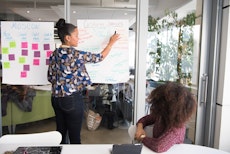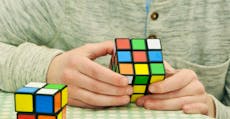Visual Learning in the Workplace
Learning is something typically associated with an educational setting like school and not people’s day-to-day professional lives. However, the concept of learning extends to how people process information – their learning style.
Nowadays, as people are constantly digesting and sharing information in the workplace, understanding our learning style is key to professional development.
This article looks at visual learning – what it means, key characteristics that visual learners often demonstrate and visual learning strategies that can help you become a more productive employee.
What Is Visual Learning?
Many different learning styles, or modalities, have been identified over the years. The three most predominant modalities form the VAK model:
- Visual
- Auditory
- Kinesthetic
The first of these, visual learning, is the process of learning through sight.
Unlike auditory learners who learn through hearing, or kinesthetic learners who learn by doing, visual learners process information more effectively when it can be seen.
This seeing of information can happen in various ways:
- Reading
- Watching videos or demonstrations
- Working with charts and graphs
- Illustrating information through pictures and diagrams
A visual learner will digest facts and figures to a higher degree and recall them for longer if they are accompanied by graphics, images or any other form of visual cue. They will also understand a process better if it is physically demonstrated, rather than verbally explained.
Visual learners also make use of color and spatial relationships. Some may even possess a photographic memory.
Why Is It Important to Understand Visual Learning?
Research shows that the majority of the population are visual learners, making it the most dominant of all the learning styles.
It is therefore an important concept for employers and employees alike to understand.
For the employer, it helps them better engage with their workforce and foster talent through effective communication strategies.
For employees, it is central to career development to know and understand their learning style.
Visual learners that better understand how to harness visual learning are more likely to progress.
Even those who are not visual learners can benefit from understanding this learning style. It is known that memory recall is enhanced when information is presented visually and, whether you realize it or not, most people are increasingly turning to visual learning strategies.
This is evident through the rise of social media. The majority of popular content on these platforms is visual since people’s busy lives no longer afford the time to scroll through reams of written information.
Even when people do read, most prefer to skim over content than study it in detail.
As attention spans continue to get shorter and shorter, the visual learning style becomes an increasingly effective method for the processing and retention of information.
Key Characteristics of Visual Learners
Identifying your preferred learning style is beneficial to understanding the kind of working conditions in which you are likely to perform at your best.
You can take this test designed by the originator of the VAK model.
If you combine this with the results of a personality test, you will get a good indication of the professional environment most suited to your individual needs.
Here are a few key characteristics that visual learners typically demonstrate to help you determine if this is your preferred method of learning.:
-
They process verbal information visually – When listening to someone speak, this type of learner will usually construct a visual interpretation of the information within their mind, sometimes even closing their eyes to do so. This helps them understand to a greater degree what is being said.
-
They are avid notetakers – Again, when processing verbal information, visual learners tend to scribble detailed notes. These are often accompanied by visual cues like arrows, circled text or hand-drawn diagrams. They may never refer to these notes again, but it is the act of seeing the information rather than simply hearing it that helps them to understand.
-
They get easily distracted when bored – When a visual learner loses interest, they tend to search for something visible to focus their attention on. For example, they may zone out of a team meeting and divert their gaze to the artwork on the wall or stare out of the window because the visual stimulus is more engaging.
-
They struggle to follow spoken instruction – Since visual learners need to associate information with something they can see, they may find it hard to work with purely verbal instructions and will quickly forget what they have been told unless they have a document to repeatedly refer to.
-
They like order and balance – Visual learners are typically well-organized and neat individuals. They get distracted by visible disorder so prefer it when things are well laid out and tidy.
-
They are generally creative – Because visual learners are drawn to things that can be seen, they are most often found working in creative industries, such as graphic design.

Tips for Visual Learners in the Workplace
Understanding your learning style can help you become a more productive, more valuable employee, subsequently helping you climb the career ladder and achieve your professional ambitions.
With that in mind, here are some visual learning strategies that you can implement to improve your work-based performance:
Step 1. Ask for Demonstrations
As a visual learner, you will likely find you quickly forget instructions given verbally. This is because you struggle to retain information not associated with some form of visual cue.
So, when learning something new, you will benefit much more if your instructor walks you through a step-by-step demonstration.
Not only does this help you break down a new concept to understand it deeply, but it also helps you remember it in the future.
Step 2. Take Your Own Notes
Note-taking is key for visual learners, so try to always keep a pen and notepad with you, particularly for important meetings or group working sessions.
Transcribing information in your own words will help both understanding and recall.
Notes do not have to be restricted to words either. Hand-drawn diagrams help your brain process information and give you a quick point of reference for future use.
Even doodles on a page can help bring ideas to life for visual learners – a skateboarding dog could be the visual anchor for the information in your training meeting.
Step 3. Make Use of Space and Color
Contrasting colors and white space help you separate out ideas and information, so put them to good use.
For example, if you are working on several different aspects of a given project, assign a color to each one and use the same color to categorize relevant notes and tasks.
Using white space in your notes makes information easier to digest and keeps your thoughts separate from one another. It helps break information down into smaller, easier-to-digest chunks.
Step 4. Organize Your Time Visually
Visual learning strategies can also help you hone your organizational skills.
To-do lists are a great tool for visual learners as they help you prioritize and make effective use of your time; you can make your day visual and understand it better.
You could also benefit from the use of an organizational wall chart, using color-coded post-it notes to highlight specific tasks.
When these colors correspond to those used in the notes, the visual stimulus helps you recall the information you need. It is a simple but highly effective use of color that can significantly boost productivity.
Step 5. Create Charts and Graphs
For visual learners who work with large amounts of data, turning this into charts and graphs makes interpretation much easier.
It also helps you explain your findings coherently – remember, the majority of the population are also visual learners – so include these visual representations in presentations or reports you pull together.
Good use of visual learning strategies is not just for your own benefit. You should be using them to ensure clear and effective communication with your coworkers too.
Step 6. Use Mind Maps to Draw Out Your Thought Process
Mind maps are another highly effective tool for visual learners. As with your notes, using a color-coded system can significantly improve information recall and help to separate out different lines of thought.
Mind maps are also great for idea development. Being able to see your thought process on paper and how all your thoughts relate can prompt inspiration and direction, since your mind is more engaged when it can physically see an idea taking shape.
Step 7. Create a Visual Workspace
Visual learners enjoy an aesthetically pleasing environment full of color, texture and thoughtful design. These are the spaces in which they are most inspired and, as such, most productive.
If working from home, you have the opportunity to create a workspace entirely to your own taste. If working from an office, try stylizing your desk to suit your visual needs.
Final Thoughts
How people process information has a big influence on their work-based performance. If the tools and resources needed are not available, both understanding and output will ultimately suffer.
Since visual learners need to see to learn, their working day should be full of visual cues that assist with information intake, retention and recall.
By implementing the visual learning strategies outlined above, you can create a working environment suited to your needs, increasing your productivity in the process.



